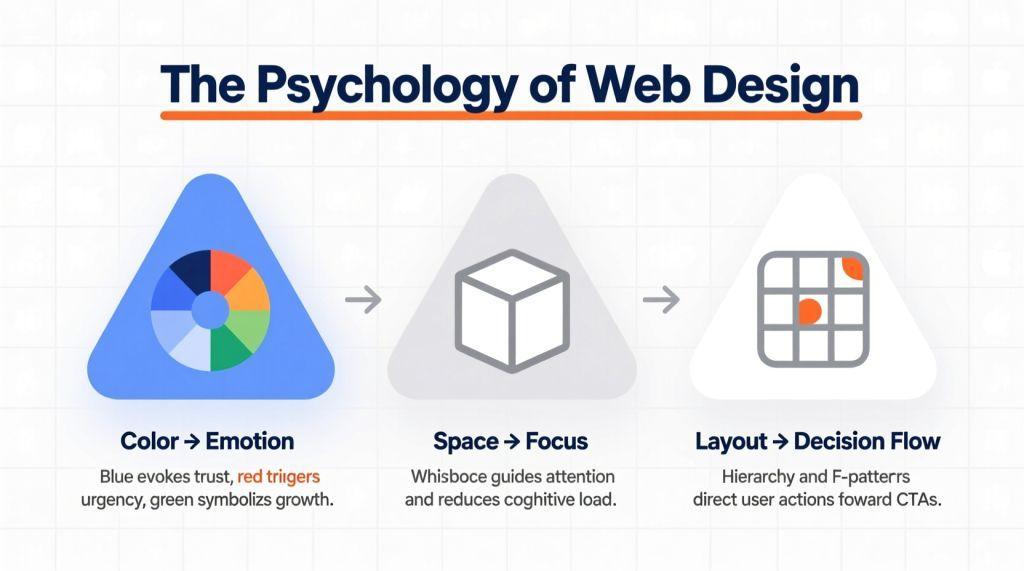Your website is a persuasion engine running on subconscious code. Every shade, margin, and grid line is a trigger that shapes emotion, focus, and action. Color primes the mood. Space steers the gaze. Layout scripts the decision path. Master these, and visitors convert before they know why.
This guide is for DTC founders hiring a web design agency, growth leads chasing incremental gains, and marketers who measure success in dollars, not likes. Design isn’t art—it’s behavioral engineering.
Color sets the emotional stage
Color is the fastest emotional API. Blue reduces anxiety in fintech. Red accelerates decisions in e-commerce. Green signals safety in health. But India reads yellow as sacred, Germany as caution. Context is king.
Contrast is the conversion catalyst. A 5:1 ratio minimum keeps users on-page; 7:1 makes CTAs unmissable. Audit every state—hover, active, visited. Use colorblind simulators; 8% of men see differently.
Systemize early. 70% neutral, 20% brand color, 10% accent. Tokenize in CSS. Users learn in one glance: purple = upgrade, gray = learn more. A web design agency that ships without tokens is selling chaos.
Space controls attention
Whitespace is psychological oxygen. Apple’s homepage uses 60% negative space to sell $3,000 laptops. Crowded competitors scream “discount.”
Cognitive load drops 20% with 32 px gutters. 1.8 line height makes copy 22% more readable. Product cards with 48 px padding lift clicks 13%. Space isn’t empty—it’s expensive emphasis.
Whitespace is a silent CTA. It isolates the hero, frames the form, and makes the buy button the only logical next step. A web design agency that fills every pixel is overcharging for clutter.
Layout is the user’s roadmap
Placement is persuasion. The eye follows reading gravity: top-left → right → down. Put the promise in the hot zone. Mobile: bottom 100 px = thumb gold.
Z-pattern for landings, F for blogs. Hero → benefits → proof → action. Each section earns the scroll. Above the fold = hook. Below = trust. Footer = safety.
Hierarchy is visual logic. 44 px H1, 28 px H2, 16 px body. Group within 24 px. Repeat CTA styles until users click reflexively. The path to purchase should feel inevitable.
Imagery and human cues build trust
Faces activate trust circuits. A customer photo with quote lifts credibility 29%. Team page with real office chaos beats stock perfection. Dog in background = human.
Contextual visuals close gaps. Show the blender mid-smoothie, not on white. SaaS dashboard with real data. Watch on wrist, not pillow. Alt text is empathy.
Microcopy kills friction. “No card required” under trial. “In stock, ships today” under cart. One line, 21% lift. Place it where hesitation spikes.
Motion and feedback keep the interaction honest
Animation is feedback with personality. 0.25 s ease on hover says “alive.” Skeleton screens beat spinners 38% for perceived speed. Respect motion preferences.
Click = ripple. Submit = toast. Error = nudge + fix. Every action gets a reaction. Silence trains double-clicks and rage.
The cost of ignoring psychology
A $200k site with zero behavioral IQ is a $200k postcard. 61% abandon due to poor UX. 47% leave if load >3 s. These aren’t tech debt—they’re trust debt.
A web design agency that speaks Human runs guerrilla tests, iterates in public, and ships winners. They bill for outcomes.
Test, measure, repeat
Data over dogma. Variant A: red CTA. Variant B: teal. Winner: 44% uplift. Audiences lie; clicks don’t.
Test one variable. 2,000 visitors. 99% confidence. Tools: Hotjar, FullStory, GA4. Review weekly. One test compounds.
Final thought
Design is psychology in code. Color primes. Space calms. Layout closes. Rig the subconscious ethically, and your site becomes a silent salesperson.
Vet your web design agency like a VC: show me the test that 10x’d revenue. The mockup is free; the 29% lift is the deal.

